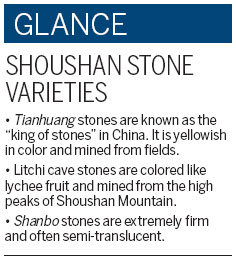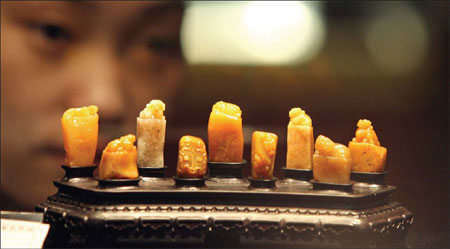Set in stone
Updated: 2012-09-28 10:34
By Zhang Lei (China Daily)
|
|||||||||||
|
Few people can afford seals made with tianhuang stones because of their skyrocketing prices. Hu Xuebai / for China Daily |
Master craftsmen help keep imperial treasure alive
During the Qing Dynasty (1644-1911), a precious stone from Fujian was said to be worth its weight in gold, literally. But the province's tianhuang stone is now worth 10 times as much. Tianhuang is one of the top varieties of precious shoushan stone from Shoushan Mountain in Fuzhou, the provincial capital. Its mild, smooth and translucent features ranked it highest among two other treasures used for making seals, bloodstone and rose quartz. The Kangxi Emperor of the Qing Dynasty had more than 100 seals made with tianhuang stones.
But the skyrocketing price of tianhuang has put it beyond the reach of many people. Similarly, the use of seals, even among artists, has been decreasing.

Only serious collectors now count among the few who can afford this traditional Chinese luxury item, and tianhuang stones are in danger of disappearing.
The small group of master carvers specializing in the stone includes Zheng Youlin, who is known for a unique, flexible carving style. His famous stone miniatures include a representative piece Bamboo of Peace, with a bamboo-shaped main body depicting the story of a little boy setting off firecrackers.
"Making use of the natural traits of the raw stone is what the art is all about," Zheng says.
"The moment I set my eyes on the raw stone, the idea of how to construct the layout had formed in my mind. The fissures on the stone were extremely suitable for depicting bamboo."
Many original owners of the tianhuang stones in their raw form treat them as family heirlooms and will not sell them unless necessary.
Zheng himself was turned down several times by the owner of the stone. But the master craftsman did not give up and even showed the owner his creations as well as several drafts of his designs.
The owner finally sold the raw stone to Zheng for 60,000 yuan ($9,516, 7,350 euros) in 2000.
Zheng's friends thought he was mad to buy a stone weighing less than 100 grams for 60,000 yuan 12 years ago.
"The stone was too rare to miss and I had a strong belief at that time that the finished product would give itself to a new and varied style. That is why I was keen to buy it," Zheng says.
He received an invitation to compete in an exquisite-art exposition two weeks later in Shanghai. Zheng decided to use his newly bought tianhuang stone to create a new piece for the competition, rather than presenting the old ones he had already made to the judges.
Doing what many thought to be impossible, Zheng completed his piece for the national contest in 10 days, just in time for the submission deadline.
"Looking back now, I cannot believe how I managed to finish the piece in such a short time. I actually spent 17 to 18 hours every day carving, polishing and cutting," Zheng says.
"The most difficult part for me was that when you cut on a tianhuang stone, sometimes it flows well with its stone texture, but sometimes in the next cut it may have a black acicula resulting in a flaw."
Zheng worked meticulously on every cut and his efforts paid off when the judges praised his work. But because he had to pay off his debts from buying the stone, he decided to sell his work to a Hong Kong collector, who bought it for 180,000 yuan.
In 2008, Zheng bought the piece back from the collector for 500,000 yuan. "Every piece I make is my child. Each has a different story behind it," Zheng says. He decided to keep this piece he bought back from the Hong Kong collector forever to mark a milestone in his art career.
Many fans and collectors of the art form attest to such importance and value.
Shoushan stone can be found only in Shoushan Mountain, in the northern outskirts of Fuzhou. The art of carving these stones can be traced back as far as the Southern and Northern Dynasties (AD 420-581). The contrast between the transience of life and the eternity of stones propelled many ancient Chinese artists to carve on the stone to convey its "resilience".
The stone was first used in burial accessories for aristocrats to show that "eternity stays with the deceased forever". At that time, carvings were simple and crude.
Shoushan stones are divided into three main categories depending on the place they are found: in the mountains, on riversides or in fields. Tianhuang stone belongs to those found in the fields. Other varieties include rose quartz, shanbo stone, litchi cave and duling stone; some of which feature mild textures while others are deemed extremely colorful or translucent. Tianhuang possesses two of these prominent features.
Later in the Song Dynasty (AD 960-1279), with further excavation in the Shoushan Mountain area, many scholars and high officials started to keep several of these carved stones on the table at home. Appreciating the precious stones became a trend even among royalty.
It was not until the Yuan Dynasty (1271-1368) that making seals with Shoushan stone became valued among the Chinese literati.
Legend has it that the Qianlong Emperor of the Qing Dynasty dreamt that the heavenly Jade Emperor gave him such a yellow stone. The emperor summoned his officials to work out the meaning of his dream. One official from Fujian province insisted the yellow stone was tianhuang. Soon, at every sacrifice ritual, the emperor ordered a tianhuang stone to be placed at the center of the altar. That made the tianhuang seals exclusive to the Chinese imperial family.
For masters like Zheng, his shoushan stone creations change according to what he experiences in life. Beginning as a hobby, then as a way of making a living, his art has become an indispensable way of nourishing his spiritual well being.
"Shoushan stones are often bright and colorful. It is just like our life. It is filled with challenges, struggles, twists and turns," he says. "As the ancient saying goes, 'as his stone, so is he'."
zhanglei1@chinadaily.com.cn
(China Daily 09/28/2012 page26)
Today's Top News
Rescuers race against time for quake victims
Telecom workers restore links
Coal mine blast kills 18 in Jilin
Intl scholarship puts China on the map
More bird flu patients discharged
Gold loses sheen, but still a safe bet
US 'turns blind eye to human rights'
Telecom workers restore links
Hot Topics
Lunar probe , China growth forecasts, Emission rules get tougher, China seen through 'colored lens', International board,
Editor's Picks

|

|

|

|

|

|






